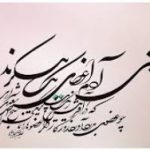
بنی آدم اعضای یکدیگرند که در آفرینش ز یک گوهرند
چو عضوی به درد آورد روزگار دگر عضوها را نماند قرار
تو کز محنت دیگران بی غمی نشاید که نامت نهند آدمی
Human beings are members of a whole, In creation of one essence and soul. If one member is afflicted with pain, Other members uneasy will remain. If you have no sympathy for human pain, The name of human you cannot retain.
These verses by great Iranian poet Sa’di is written in entrance to the Hall of Nations of the UN building in New York. We can distinguish two periods of Persian poetry:
one traditional, from the tenth to nearly mid, twentieth century; the other modernist, from about World War II to the present. Within the long period of traditional poetry, however, four periods can be traced, each marked by a distinct stylistic development. The first of these, comprising roughly the tenth to the twelfth century, is characterized by a strong and an exalted style (sabk-e fakher). One may define this
style (generally known as Khorasani, from the association of most of its earlier representatives with Greater Khorasan) by its lofty diction, dignified tone, and highly literate language. The second, from the thirteenth to the fifteenth century, is marked by the prominence of lyric poetry, the consequent development of the ghazal into the most significant verse form, and the diffusion of mystical thought.
Its style is generally dubbed Eraqi because of the association of some of its earlier exponents with central and western Persia (even though its two major representatives, Sadi and Hafez, were from the southern province of Fars); it is known by its lyric quality, tenderness of feeling, mellifluous meters, and the relative simplicity of its language. The third period, which extends from the fifteenth well into the eighteenth century, is associated with the Indian style of Persian poetry (sometimes called Isfahani or Safavi). It has its beginning in the Timurid period and is marked by an even greater prominence of lyric poetry, although it is somewhat devoid of the linguistic elegance and musicality of the preceding period. The poets of this period often busied themselves with exploring subtle thoughts and farfetched images and elaborating upon worn-out traditional ideas and metaphors. The fourth period, from approximately the eighteenth to the mid-twentieth century, is known as the Literary Revival (bazgashte adabi).It features a reaction against the poetic stagnation and linguistic foibles of the late Safavid style, and a return to the Eraqi style of lyric poetry and the Khorasani style.
